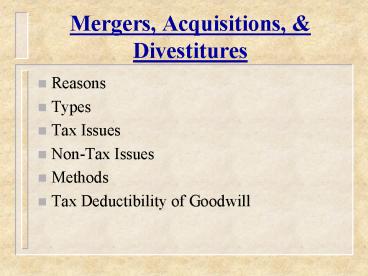Mergers, Acquisitions, - PowerPoint PPT Presentation
1 / 18
Title:
Mergers, Acquisitions,
Description:
Mergers, Acquisitions, & Divestitures Reasons Types Tax Issues Non-Tax Issues Methods Tax Deductibility of Goodwill Reasons for Mergers/Acquisitions 1) To improve ... – PowerPoint PPT presentation
Number of Views:475
Avg rating:3.0/5.0
Title: Mergers, Acquisitions,
1
Mergers, Acquisitions, Divestitures
- Reasons
- Types
- Tax Issues
- Non-Tax Issues
- Methods
- Tax Deductibility of Goodwill
2
Reasons for Mergers/Acquisitions
- 1) To improve economic efficiency
- 2) To extend the power base of
management - 3) To effect transfers of wealth between
classes of stakeholders
3
Reasons for Divestitures
- 1) To focus on core competencies
- 2) To free managers of the divested business
to focus on the divested firm - 3) To solve market mispricing
- 4) To gain greater access to capital markets
4
Types of Mergers/Acquisitions
- Freestanding companies can acquire
- 1) Other freestanding companies
- 2) Subsidiaries of other companies
- Acquisitions can be structured to be
- 1) Taxable (when the acquirer uses cash)
- 2) Tax-free (when the acquirer uses mostly
stock)
5
Types of Divestitures
- Tax-Free Spin-off Involves the division of the
parent corporation into two or more distinct
corporations. - Equity Carve-out Involves the sale of a portion
of a subsidiarys equity for cash.
6
Major Tax Issues
- 1) Shareholder tax liabilities
- 2) Effect on tax attributes
- 3) Corporate-level tax effect of the merger,
acquisition, or divestiture - 4) Change in the tax basis of the assets of the
target or divested subsidiary - 5) Effect of leverage on mergers and
acquisitions
7
Shareholder Tax Liabilities--Mergers/Acquisitions
- If taxable Purchase price - Basis
in stock Gain recognized by target
shareholders - Requirement for a tax-free acquisition
- Target shareholders must maintain a continuity of
interest--50 of total consideration paid is
acquiring-firm stock - Note Tax-free transactions can result in a
taxable gain for target shareholders to the
extent they receive cash!
8
Shareholder Tax Liabilities--Divestitures
- Spin-off No taxable gain or loss recognized by
the divesting corporations shareholders - Equity Carve-out No taxable gain or loss
recognized by shareholders - Sale of Division or Subsidiary for Cash No
taxable gain or loss recognized by the divesting
corporations shareholders unless proceeds are
distributed to them by the divesting corporation
9
Effect on Tax Attributes
10
Corporate-Level Tax Effect--Mergers/Acquisitions
- If acquisition is accomplished through the
purchase of assets in a taxable transaction, a
taxable gain or loss is recognized by the target
corporation - If acquisition is accomplished through the
purchase of stock in either a taxable or tax-free
transaction, no gain or loss is recognized at the
corporation level
11
Corporate-Level Tax Effect--Divestitures
- Subsidiary Sale Purchase price of
stock or assets - Sellers basis in stock
or assets Taxable gain (loss) recognized
by seller - Equity Carve-out Generally does not result in a
taxable gain or loss for the divesting
corporation - Spin-off Since a spin-off is usually tax-free,
no taxable gain is recognized under typical
circumstances
12
Change in Tax Basis of Assets of the Target or
Divested Subsidiary
- A step-up in the tax basis of assets of an
acquired business to the purchase price creates
increased future depreciation deductions, which
provide valuable tax savings. - This is common in subsidiary sales, but
acquisitions of freestanding C corporations are
limited in this practice by the Tax Reform Act of
1986.
13
Non-Tax Issues in Mergers, Acquisitions, and
Divestitures
- Financial Reporting Costs
- Purchase Accounting
- Pooling of Interests Accounting
- Transaction Costs
- Contingent or Unrecorded Liabilities
- Managerial and/or Control Issues
- FASB eliminated this method after 2001
14
Five Basic Methods to Acquire a Freestanding C
Corporation
- As taxable purchase of Cs (for C Corp) assets
- As taxable purchase of Cs stock followed by an
I.R.C. 338 election - As taxable purchase of Cs stock not followed by
an I.R.C. 338 election - As acquisition of Cs stock in a tax-free
exchange - As acquisition of Cs assets in a tax-free
exchange
15
Four Methods to Divest a Subsidiary or Line of
Business
- Subsidiary Stock Sale
- Subsidiary Asset Sale
- Spin-off
- Equity Carve-out
16
Tax Deductibility of Goodwill Under I.R.C. 197
- I.R.C. 197 makes goodwill tax-deductible.
- However, goodwill is only tax-deductible when the
tax basis of the acquired firms assets is
stepped up. - This occurs frequently in subsidiary sales and in
acquisitions of conduits but not in acquisitions
of freestanding C corporations.
17
Structures Employed in Acquisitionsof
Freestanding C Corpsand Tax Implications
18
Divestiture Methods and Tax Implications

